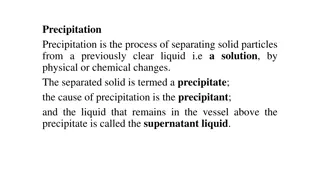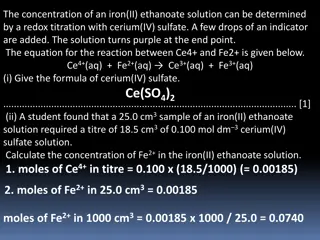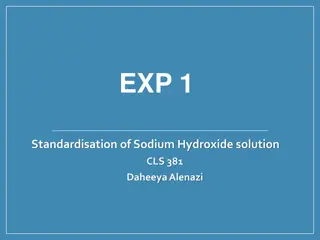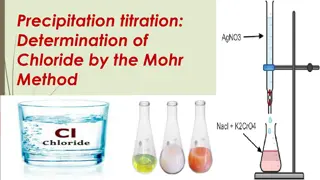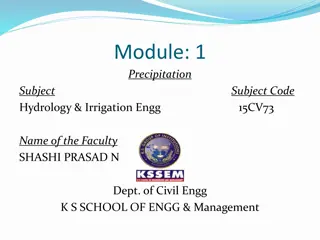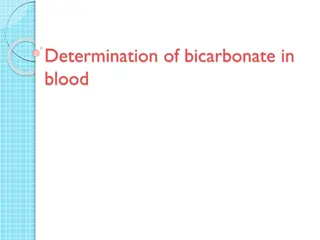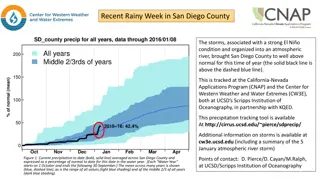Understanding Precipitation Titration in Analytical Chemistry
Precipitation titration is a method where a precipitate is formed by converting one reacting species. An example is the estimation of chloride using AgNO3, where AgCl is precipitated. The titration is based on the formation of precipitates, and suitable conditions, indicators, and methods are vital for accurate results. Potentiometric and conductometric methods, as well as the use of indicators like adsorption indicators, play key roles in precipitation titrations.
Download Presentation

Please find below an Image/Link to download the presentation.
The content on the website is provided AS IS for your information and personal use only. It may not be sold, licensed, or shared on other websites without obtaining consent from the author. Download presentation by click this link. If you encounter any issues during the download, it is possible that the publisher has removed the file from their server.
E N D
Presentation Transcript
PRECIPITATION TITRATION Name of the instructor:U.Nithya M.Sc.,M.Phil.,
PRECIPITATION TITRATION: It is a titration in which precipitates are formed. One of the reacting species is coverted into a precipitate. Example: Estimation of chloride using AgNo3. Here Agcl is precipitated. cl-+ AgNO3-------------- Agcl + No3- Explanation: When chloride solution is titrated against AgNo3chloride ions are precipitated as Agcl. Such a titration is known as precipitation titrations. Principle: In precipitation titrations the formation of precipitates is used as the basis of the titration.The point at which as stoichiometric amount of the titrant is added to precipitate completely the ion to be estimated presented in a given volume of the solution is the end point. Conditions: 1.The precipitation reaction must attain equilibrium very rapidly after each addition of the titrant to the analyte. 2. Co-precipitation,occlusion,adsorption of foreign ions should not interfere with the reaction involved in precipitation titration. 3. A suitable indicator which can indicate the stoichiometric equivalence Point should be available.
Procedures: i) Potentiometric method: when the titrant is added to the analyte the potential of the system changes abruply in the neighbourhood of the equivalence point. If we plot the emf of the system against the volume of the titrant in ml we get a curve as shown in fig. Near the end point there is a sudden change in the potential of the system.
ii) Conductometric method: when titrant is added to the analyte progressively the ions are removed from the reaction mixture. Eg: AgNO3 + Nacl -------------- Agcl + NaNo3 Ag+ +NO3 -+ Na+ +cl --------------- Ag ++cl -+ Na ++No3- If AgNo3is the analyte and Nacl is the titrant then during the titration the less mobile Ag+ions are replaced by more mobile Na+ions.
Thus during the titration when more and more of Nacl is added.more and more of Na+is introduced and so the conductance increases regularly. At the end point we have Na+and NO3-only. if we add any more amount of Nacl conductance increases rapidly. It is because Nacl is a strong electrolyte and the addition of it causes an increase of Na+and cl-ions. The curve obtained in such a titration is shown in fig. The end point is given by the break in the curve X.
iii) Using indicators: The precipitation titrations are also conducted using indicators to fix the end Point. For this purpose we use a special type of indicators called adsorption indicators. They are indicators which change their colour at the end point because of adsortion. Eg: Flurescein is used as indicator during the titration of chloride with AgNO3.
COMPLEXOMETRIC TITRATION: In these titrations ions are converted into a soluble slightly dissociated ions or compounds. Principle: Metal ions can be determined by titrating them with a reagent that complexes them in solution. The solution to be titrated is buffered at a suitable PH an indicator is added and the metal ion is titrated with a standard solution of the complexing agent. A sharp colour change marks the end point of the titration. comoleximetric titrations are convenient and accurate. They have replaced time consuming gravimetric procedures. Except for the alkalo metals most metal cations can be determined by titration with a suitable complexing agent.
Determination of end points in complexometric titrations: In complexometric titrations the end points are determined with a help indicators called metal ion indicators. Metal ion indicators: They are organic dyes which are used to determine the end point in complexometric titrations. Eg: i. Erichrome Black T (EBT) ii. Murexide Principle: The metal ion indicator exhibits one colour when they are complexed. With the metal ion and a different colour when they are free.
APPLICATIONS: compleximetric titrations are used to i. determime hardness of water ii. Ni and many other ions. 1. Determination of hardness of water: * The hardness of water is due to the presence of calcium and magnesium salts. * To eatimate the total hardness of water the sum of ca2+ and Mg2+ions present must be known. * First by titrating a standard EDTA solution against a measured quantity of hard water using EBT the total hardness of water estimated. * second titration magnesium is converted into its hydroxide and is removed. * From the second titration the amount of ca2+ is determined. * From these two values the total amount of Mg2+is determined.
Procedure: 40ml of water samples is taken in a conical flask and the 20ml of ammonium buffer is added to keep the pHbetween 8-10.it is diluted to 100ml distilled water and a pinch of EBT indicator. The solution is warmed to 60 c and it is titrated against standard EDTA (0.01M). The end point is the change of colour from wine red to blue. Let the titre value be x ml. Another 40ml of the sample is taken in a conical flask and 10 ml of 2M NaOH is added followed by a pinch of murexide indicator. The solution is diluted to 100ml with distilled water and it is titrated against EDTA. The end point is the change of colour from pink of blue. Let the titre value be y ml.
Calculation: Factor value for calcium Fcais 1 ml of EDTA = 0.4 mg of calcium Factor value for magnesium Fmgis 1ml of EDTA = 0.243 mg of magnesium Amount of ca in 1000ml of the sample= 0.4 x y x 1000/ 40 = A mg = A ppm Amount of Mg in 1000ml of the sample = 0.243 x (x-y) x 1000/ 40 =Bmg =B ppm Total hardness = A+ B ppm
2. Determination of Ni: Nickel can be estimated by titrating a solution of nickel against standard EDTA. Muroxide is used as indicator for this titration. The PHis to be maintained between 10 and 11. The end point is the xhange of colour from yellow to blue violet. The same titration can bedone with Eriochrome black T indicator also in that case the end Point is the change of colour from blue to red. The PH range is 7to11. Titration curve: These are graphs drawn to find out the end point in a titration. plots of analogous data for titrations involving redoc precipitation and complexometric titrations also are similar to the one shown in the diagram.






